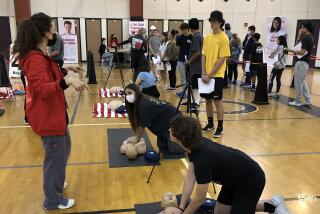Heart attacks in public places: why you’re more likely to survive
- Share via
Every year, some 300,000 Americans suffer a heart attack outside of a hospital, and the overall statistics are pretty grim: only 7.9% survive.
So, what is it about the lucky 23,700 that helps them buck such long odds?
One thing those survivors are likely to have in common is that their first heart attack symptoms seem to have come on in a public place. Another is that the heartbeat irregularity that signals trouble is likely to be ventricular fibrillation, a fast or erratic electrical signal in the heart’s lower chambers that causes them to quiver uselessly rather than pumping blood out of the heart and into the rest of the body.
Coincidence? A national consortium of researchers led by Johns Hopkins University’s top doctor, cardiologist Myron L. Weisfeldt, thinks not. Their study, part of the Resuscitation Outcomes Consortium, was published this week in the New England Journal of Medicine.
Ventricular fibrillation, or pulseless ventricular tachycardia (in which blood has ceased altogether to circulate) is bad news indeed. But the person who suffers this sudden electrical storm in his heart is a bit luckier these days if he experiences it in a public place. That’s because ventricular fibrillation can be knocked back to a normal heart rhythm by a sudden jolt of electricity--the kind supplied by an automatic external defibrillator (or AED).
And these days, AEDs have become ubiquitous in public places--schools, gyms, office buildings, airports and casinos. No surprise, then, that when people out and about suffer a sudden heart attack of the sort that these machines can disrupt, their greater availability should translate into higher survival rates.
At home, the picture is a bit different. The Hopkins researchers--culling heart attack data from 12,933 sudden cardiac arrests--found that nearly three-quarters occur in a residence. And, compared with heart attacks suffered by those in public places, far fewer of these in-home heart attacks--between a quarter and 36%--were characterized by the distinctive erratic beat of ventricular fibrillation (instead, they may have been a result of heart failure, a structural abnormality elsewhere in the heart, blocked arteries or a sudden embolism--problems that cannot be zapped with a sudden shock). Among people whose heart attack came in a public place, 38% to 79% had ventricular fibrillation or pulseless ventricular tachycardia--meaning an AED can be life-saving.
People who have a heart attack at home, the researchers surmised, are probably more likely to have some underlying illness that may limit the time they spend out and about in public. And because their heart attacks are much less likely to be short-circuited by a jolt from an AED, these people would be just as well served by having caregivers who are skilled in cardio-pulmonary resuscitation (or by 911 dispatchers who are good at talking a bystander through these life-saving compressions) as they would having an AED in their home.
Bottom line, according to the researchers: Keep AEDs widely accessible in public places. But to save lives at home, investments in CPR training of citizens, emergency dispatchers and caregivers is a better bet.






